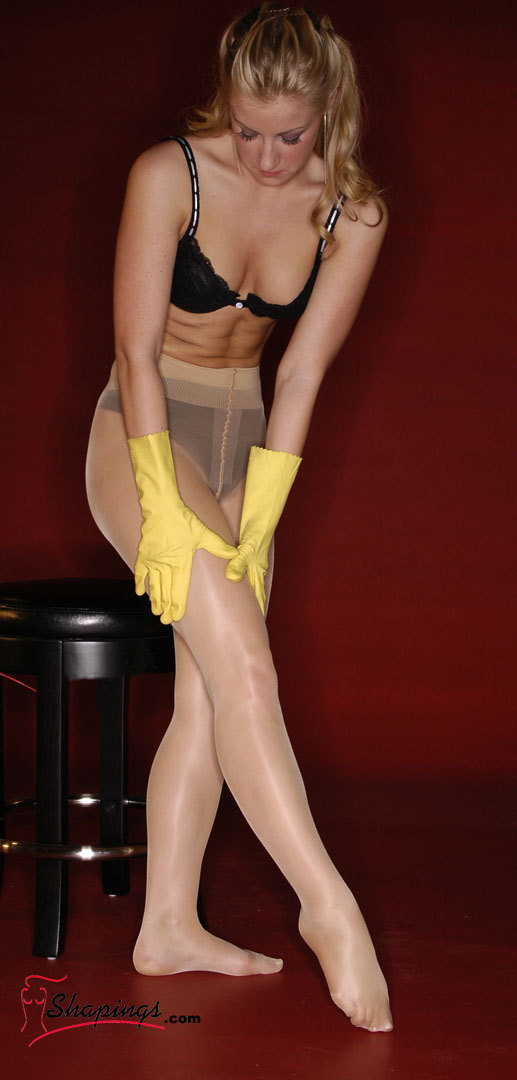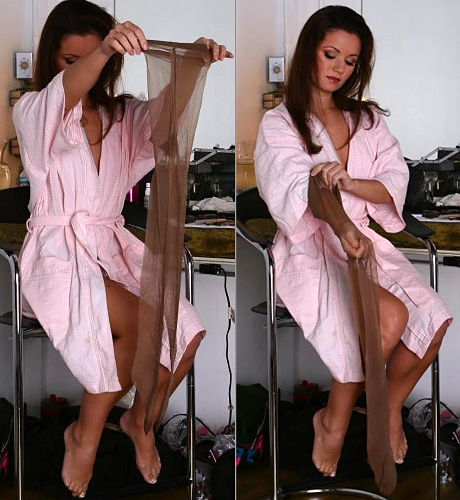
How do you make your tights last as long as possible? A good question, especially if you’re planning to buy some very expensive hosiery. Here is an extensive list of some tips to help:
- Get the right size
- Wash before wearing
- Smooth fingernail rough spots and edges
- Smooth rough skin
- Moisturize your legs and feet
- Take off rings, bracelets, and wrist watch
- Use glove liners
- Put on hosiery the safe way
- Wear slippers or socks
- Mind your shoes
- Mind clothes
- Mind your venue
- Repair any holes
- Check your seams
- Give them a rest
- Beware of your romantic partner
Get the right size
Yes, believe it or not, the right size is really very important. Obviously, I mean the size being large enough for you (too large will simply fit loosely and bag easily). Each manufacturer has their own proportions for each size. You may want a certain style of tights from a specific brand, but find that they fit you very snug. If your proportions are outside the recommended size, you will be straining the seams more than they were designed for. High quality tights will generally take the extra strain much better than cheaper ones. But, it’s very likely they won’t last as long as they would if they fit properly. High tech stitching machines do an amazing job, but there are always variations involved, even on high end tights. Always inspect them first, to be sure there are no defects. Once you start wearing them, make sure to inspect your panty/brief seams periodically. The easiest way is when you’re taking them off. Pull them down below your waist. Lay down on your bed facing up, looking towards a bright window. Raise your legs and, keeping them slightly apart to keep some tension in the tights, look at the seams starting around the gusset and follow them to the waistband. You will see the mesh of the fabric easily, and you may spot some of the microscopic holes to be larger than the rest. Those are your stress points. Remember them next time and see if they get any larger. If they do, dab them with some clear nail polish or whatever you use to stop runs. This will help reduce the stress points.
Wash before wearing
They’re brand new, they have that “new hosiery” smell, so why would you need to wash them? Well, washing them actually makes the hosiery a little more stretchy and snag resistant. Any remnants of manufacturing oils are flushed out, which is a good thing. Also, be sure to use a soap that is especially formulated for hosiery. I have a write-up you should check out, entitled “how to clean your tights“.
Smooth fingernail rough spots and edges
Nails are probably the worst offender when it comes to fine hosiery. Naturally, you want your nails to be smooth, so buffing them periodically with an emery board or other kind of file is a really good idea. Generally you can feel rough spots or sharp edges on your nails just by rubbing them over your fingers. But, a commonly overlooked area is the sides of the nails, where the skin can roughen. This is especially common in the drier months. Be sure to trim off excess skin and file down any rough spots.
Smooth rough skin
We all have calluses on our feet, most notably on the heels. They are important to protect the skin underneath and help avoid feeling the discomfort of rough surfaces when walking barefoot. But in the cooler drier months, those calluses get a little harder and can tend to form rough spots. This becomes more of a problem for folks who are older, as the skin oil glands start to shrink or dry up, making drier skin as a result. Use an exfoliating or buffing bar, or a rasp. I prefer a buffing bar, which is a hard contoured block with a rough texture (usually smoother on one side and rougher on the other side). Use this first thing in the morning just after getting out of bed, when your skin is completely dry. You simply rub the bar or rasp over the edges and bottoms of your heels. Also do this to the ball of your foot and outer edge of your big toe, anywhere you feel rough spots. Do this once a week or whenever you feel like it. You’ll be amazed and how smooth your skin feels after doing this and your hosiery will have one less thing to wear them down. You see, you may get your hosiery on without any snagging, but rough skin will slowly break down fibers in the material and eventually lead to holes in the feet.
Moisturize your legs and feet
Another great way to help lessen rough skin is to moisturize. You probably already do that with your face and hands. But also be sure to lightly moisturize your legs and especially the bottoms of your feet. Apply enough so that you feel the skin becoming a little more pliable, but not too much that you feel a prominent layer of lotion on your skin.
Take off rings, bracelets, and wrist watch
If your rings, bracelets, or watch has some sharp points or edges that can snag, take them off, or just be very mindful of them. If you have rings you’d rather not take off, use glove liners.
Use glove liners
Thick opaque tights are naturally more durable than sheer pantyhose, so as long as your fingers are smooth and free of sharp or rough edges, you’ll be fine. However, if you really want to guarantee no snagging from your hands, put on a pair of thin glove liners. They’ll protect your hosiery completely and still leave you enough dexterity to put them on. You can also use very fine knit gloves. I don’t recommend latex–this isn’t surgery or like washing dishes! 😉

Put on hosiery the safe way

Putting on hosiery (from “Joy of Tights”)
Most women know that when putting on pantyhose, the best thing to do is to roll up the legs first, rather than sliding your feet against the entire length of the leg material. It’s not a bad idea to do this with your tights, especially if you haven’t buffed or moisturized your feet in a while. But if your hands are free of snag points, you can usually get away with putting your arm into the leg, grabbing the toe, and gathering the leg up into a ring. The recommended steps have been blogged about all over the Internet (the best I’ve found so far is the Joy of Tights), so I won’t repeat them here. Falke made a little quick reference chart (here), but it’s very basic. I actually saw one interesting technique that recommends turning the hosiery completely inside out! You then push the end inward a little to form a cup, slip your toes in, then gradually roll the hosiery over your foot and up your leg. It’s a clever technique that helps minimize the movement of the material over your legs as you put on the hosiery. It is probably a good idea to do with sheer pantyhose, but I think it’s overkill when it comes to opaque tights. Still, if you’re willing to go the extra mile, you might want to look into this technique. Also, if you’d like to see a video, I recommend watching this short one on YouTube: How to put on Pantyhose or Tights.
Wear slippers or socks
So, you’ve got your tights (or pantyhose) on and you’re not quite ready to put on your street shoes. You head to the bathroom to finish getting ready, or make a segue to the kitchen for another cup of coffee. As you’re walking, any rough bits on the floor are getting a chance to greet your feet and possibly damage your hosiery. Definitely put on slippers or socks if you’re not quite ready for your street shoes. This is true even for carpets, as the edging at doorways can have snagging spots.
Mind your shoes
It’s time to put on your street shoes. When you select a pair, beware of any rough or hard edges on them. If you’ve chosen shoes you wear often, they’ll probably be fine. The real trick of it is new shoes or boots where you may have worn socks with them before, but not tights or pantyhose. And for men, you’ve generally got more challenges because men’s knit socks are much more durable than fine hosiery. You may not realize how torturous your shoes may be to tights. What your socks withstood without trouble before, your tights may be vulnerable against. Now, what if you do have a rough spot? You may be able to take care of it with a nail file. Trim off or buff down any hard pieces of leather or hard thread ends on the interior and edges around the ankles (of course being careful not to weaken the shoes by cutting an important thread). On boots, make sure the inner sides that touch your calves are free of snag points. You may also want to consider putting on a pair of socks for an added layer of protection, especially if your high shoes or boots are a little loose.
Mind your clothes
If you’re wearing shorts or pants over your tights, be sure they’re smooth and free of rough areas on the inside and edges. Generally, formal style shorts or pants will be fine. With pants, lined is best. Jeans may feel comfortable, but they can have slightly rough seams that won’t be kind to your tights. You may want to identify certain shorts or jeans that you’d never wear with your best hosiery on underneath, and choose accordingly.
Mind your venue
Where are you planning to go? Are you going to be taking a walk through a nature preserve where you might brush up against plant life? Will you be lying down on a grassy lawn without a blanket, sitting on rocks near the shore, or relaxing on a park bench? Are you visiting some friends who have cats and/or dogs that may jump up on you? Just consider if you might be visiting any place that is snag prone, then choose your hosiery accordingly (i.e. maybe put on your less expensive hosiery).
Repair any holes
Any snags that create holes are usually obvious, as they will be visible on your legs. Also, depending upon the fit of the hosiery, there may be added stress to seams on the brief, particularly around the gusset, where holes may develop. Naturally, it is best to address them as early as possible, before they enlarge or create runs. There are a number of repair techniques available, some using clear nail polish and other adhesives to keep the hole from widening and possibly seal it off. Unfortunately the leg area doesn’t leave many options, as any extensive repair work will be more obvious. Whatever you do, always apply repairs from the inner side of the material. For holes on the brief/panty area, I use a combination of clear nail polish, followed by Aleene’s Fray Stop. This seems to work very well and holds up for the long run, perhaps better than clear nail polish.
Check your seams
Hosiery manufacturing has come a long way and high-tech flat seams are very well made for the most part. However, sometimes there can be defects that are too small to be detected by the quality assurance inspector. For instance, a fraying thread may pass a pre-purchase check, but then break after a few wearings. That can trigger a cascade unraveling of a seam thread that grows, creating stress on other threads that may break, and so on, until you discover a separated seam the next time you put the tights on. Once in a while, inspect the seams at stress points. If you see some fraying going on, take out some thread and fix it. A few minutes of simple sewing can stop that fraying in its tracks and keep the seams intact for the life of the tights.
Give them a rest
Do you have a couple pairs of favorite tights that you wear more than any others? If so, try not to wear the same pair more than one day in a row. It’s true that you don’t need to wash your tights after each day of wearing. But it’s best to give them a rest after wearing one day. This allows the fibers to contract back to their original shape and they’ll last longer.
Beware your romantic partner
So, you take all this care to be sure your hands are snag free, but what about your romantic partner who may like to touch your legs? If they aren’t as careful as you are and might have rings or a watch that could snag your tights, either kindly remind them to be careful or gently guide their hand to a safer location. 😉 I doubt this will be a common problem, but… for a woman who might have a boyfriend whose job causes rough hands, or a guy who has a girlfriend with rings and bracelets that love to snag hosiery, it’s just something to keep in mind. 😉
OK, that’s it! I know it’s a very long list, but I wanted to be sure to catch anything noteworthy. Ultimately, we each find ways that work best for us over time. If you have some to add, please feel free to post here. Thanks!



Pingback: How do you clean your tights? | Tights For Men
Great piece full of sound advice and information.
Thanks! 🙂
I updated it a little, with a few minor corrections and a section on “repairing holes”.
Pingback: Poll: How do your tights typically wear out? | Tights For Men